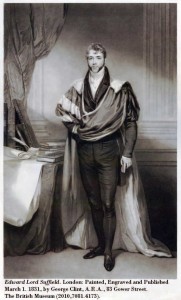Was the street named for a tireless English abolitionist?
By Annemarie Brissenden
Harbord Street may have been named for an early nineteenth-century advocate of parliamentary reform and tireless crusader to end slavery, says a past board member of the Harbord Village Residents’ Association.
“I started asking the question a few years ago,” explains Wendy Smith. “I’ve lived in Harbord Village for almost 20 years, but nobody knew about [how the street got its name]. It’s really been a mystery.”
A mystery, but an irresistible one for the amateur historian, who after approximately three years, has come to theorize that Harbord Street is named for Edward Harbord, the 3rd Lord Suffield.
Suffield was born in England in 1781. A second son who gained financial independence through an advantageous marriage, he represented Shaftesbury in the House of Commons, becoming a member of the House of Lords when he succeeded his elder brother in the barony. A self-described liberal who was a Whig, Suffield made his mark as a member of a parliamentary committee investigating “the condition and treatment of slaves”. He was the only abolitionist on a committee that mostly comprised owners of plantations in the West Indies, and came close to collapse during the committee hearings.
Suffield’s role in getting the Slavery Abolition Act of 1833 passed, relates Smith, cannot be understated. She quotes one of his contemporaries, who said “his voice, single as it often was, could not but be listened to.”
The abolitionist never visited Toronto, but Smith believes many on this side of the pond would have been aware of him, including the heads of the Crookshank, Denison, and Baldwin families, prominent landowners who also were active in the politics of the day.
“I like to imagine them in front of the fireplace in one of their homes, brandies in hand, talking over things,” says Smith. Things like what to name the “ramrod straight street” south of Bloor Street that traversed their adjacent properties.
She argues that the abolition movement was regularly chronicled in the newspapers and memoirs of the day, and many British abolitionists moved to Canada bringing with them their stories.
Among them was author Susanna Moodie, who in England knew the secretary of the abolitionist movement, and became very good friends with Robert Baldwin after her arrival in Upper Canada. Perhaps Smith’s most exciting — and recent — discovery is that in 1834, Suffield sponsored the immigration of a group of farm labourers to Upper Canada. A decade later, in 1854, Harbord Street had its name.
Smith is still developing her theory; she hopes to travel to England to find the records of those who resettled here, perhaps uncovering a more conclusive connection.
“It’s a splendid piece of research,” says David Raymont, the president of the York Pioneer and Historical Society. Known as the York Pioneers, the city’s oldest heritage group was founded in 1869 by a group of men — many of whom where veterans of the War of 1812 — who could remember when Toronto was still called the Town of York.
Smith, a member and former board member, presented her theory at the society’s December meeting.
The avid student of Toronto’s early history, as well as the history of Upper Canada, won a Heritage Toronto Award of Excellence (Media) in 2014 for the Toronto Park Lot Project: an interactive online map with clickable layers that allows users to uncover how history and geography intersect.
“It’s important going forward to know where we came from,” says Smith. “As I have learned [more and more], I am just astonished at how profoundly ignorant I have been all my life about the place I live.”
“There’s so much to be learned about the development of this city,” adds Raymont. “People who did things didn’t keep records or share why they did things, and that disconnects us from the roots and concepts of people who shaped it.”
Wendy Smith will present Edward Harbord, 3rd Lord Suffield, at the Palmerston Branch of the Toronto Public Library on May 26 at 7 p.m. To learn more about the Park Lot Project, please visit http://wendysmithtoronto.com/parklotproject/.
To learn more about the York Pioneer and Historical Society, please visit www.yorkpioneers.org.
This article has been updated since it was originally posted: 1844 was corrected to 1854, and Edward Suffied, 3rd Lord Suffield, was corrected to Edward Harbord, 3rd Lord Suffield. The Gleaner regrets the error.

